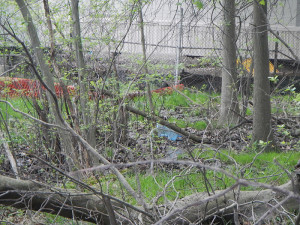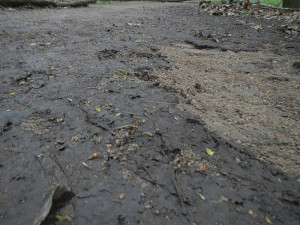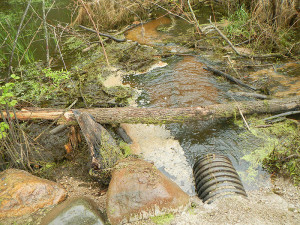On the evening of Monday, May 12th, an intense storm dropped more than two inches of rain in North Olmsted, Ohio on ground which was already saturated from previous rainfall. Flooding affected many of the city’s homes, businesses, parking lots and streets, and local news outlets featured photos of partially submerged cars and pick-up trucks at Great Northern Shopping Mall the next day. The Rocky River Valley was flooded badly, too.
Wednesday, May 15th, less than 48 hours after the storm, two volunteers hiked Cleveland Metroparks trails behind the Rocky River Nature Center. Coincidentally, both volunteers had been trained to report water pollution incidents at the Sierra Club’s Water Alert Reporting Network (WARN) training the evening before.
The North Olmsted Waste Water Treatment Plant is perched on a high plain nestled in the sylvan Rocky River valley. Below the plant, the Cleveland Metroparks’ Rocky River Reservation broadens to include two abandoned channels of the West Branch of the Rocky River. On their way down to the Rocky River, the channels weave around a high hill called Mount Pleasant. Part of the western channel is dredged and impounded to form West Channel Pond, the water feature beside the Rocky River Nature Center.

Blue shopping bag in a bush just south of the North Olmsted Waste Water Treatment Plant
Wednesday afternoon, both channels on either side of Mount Pleasant smelled strongly of untreated sewage. The creek, which runs alongside the North Olmsted Waste Water Treatment Plant and through the northern channel, had garbage bags festooning the bushes and tree branches up to 10 feet above the usual water level. (The piped outflow of the North Olmsted Waste Water Treatment Plant flows to the Rocky River underneath the creek.)
On the other side of Mount Pleasant, what appeared to be sludge covered about 20 feet of a low spot on the Mount Pleasant Loop trail. Looking up the dry watercourse from the sludge-covered trail toward the waste water treatment plant a couple of hundred feet away, pools, gullies, garbage and scoured leaf litter were evidence the flow emanated from the direction of the plant. A blue bag 4 feet up in a bush near the waste water treatment plant indicated the flood level.

Sludge on the Mount Pleasant Trail
Downstream, the dry watercourse flowed into West Channel Pond. Yes, West Channel Pond smelled of sewage, too.
To the north and upstream of West Channel Pond, where there had previously been a wetlands viewing platform on the water, the volunteers watched water drain out of two culverts under West Channel Pond Trail toward West Channel Pond. The streams each had 6 foot long reddish-brown plumes with scum on either side. The smell of partially-treated sewage hung in the air.
The WARN volunteers wrote a WARN incident report mostly to practice what they had learned the night before at the WARN training. They did not think anybody would be interested in the report. However, several people from the Sierra Club expressed dismay at the incident and appreciation for the report. Not only did the report cover an incident the Sierra Club considers significant, the report served as a test case. The WARN incident report system is under development. We’re all practicing and learning, and incidents such as these give Sierra Club staff and volunteers an opportunity to reach out to municipalities and agencies to help them identify problems.

Reddish brown plume and scum in water draining under the north side of the West Channel Pond Trail
Before the training, the volunteers knew of no simple way for citizens to report a water pollution incident. The WARN incident report is a good start. Maybe, someday there will be an even simpler way to report pollution incidents – a way which would generate a timely, coordinated and appropriate response from all appropriate agencies. Imagine a single phone number which, like 911, would put a caller in touch with the proper response team for a pollution incident!
Note from Sierra Club Staff
The North Olmsted Waste Water Treatment plant is under capacity. The amount of rainfall that particular Monday evening was a record breaking event for the community of North Olmsted. Stormwater infiltrated and inundated the sanitary sewer network feeding into the treatment plant. Overwhelmed by excess flows to and within the plant, the plant released partially-treated sewage into Cleveland Metroparks Rocky River Reservation and the Rocky River itself. Where the sanitary sewers are not connected to the storm sewer system, as in North Olmsted, this type of event is called a Sanitary Sewer Overflow, or SSO. Ongoing construction at the plant, which has a history of SSOs, will help to address the problem. But there is more that can be done both here and in other communities, and we can all help.
Sierra Club will be working with flood-prone communities to increase reporting from homeowners and businesses of basement floods that result from sanitary and combined sewer systems as they become flooded with rainwater. If you experience a sanitary basement flood at your home or business this rainy season, please report the incident to your local sewer authority. This data helps public works managers and Ohio EPA track and pinpoint problem areas so that communities can identify necessary repairs. This data also points to locations where green infrastructure projects may have the most beneficial impact. The City of North Olmsted is working toward putting a basement flooding report form online, and Sierra Club is working toward a similar goal with other communities.
If you are interested in more ways to get involved through hands-on training or volunteering, please follow this link to the Ohio Chapter’s Clean Water Campaign page. There you can sign up for a future Water Sentinel or WARN training, or be notified of upcoming stewardship events!